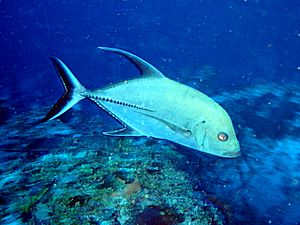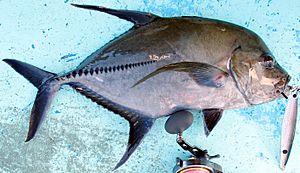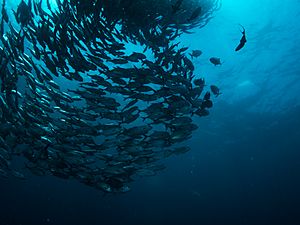Black jack facts for kids
Quick facts for kids Black jack |
|
|---|---|
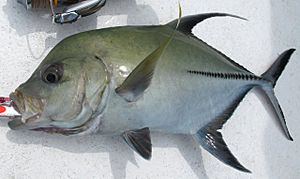 |
|
| Conservation status | |
| Scientific classification | |
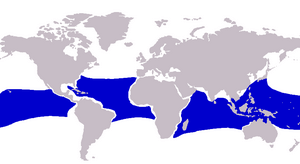 |
|
| Approximate range of the black jack | |
| Synonyms | |
|
The black jack (scientific name: Caranx lugubris) is a large ocean fish. It is also known as the black trevally, black kingfish, coal fish, or black ulua. This fish belongs to the Carangidae family, which includes jacks and trevallies.
Black jacks live in warm, tropical waters all around the world. You can find them in the Pacific, Atlantic, and Indian Oceans. They are often seen near islands like Hawaii and the Caribbean. These fish prefer deep waters, usually around reefs and underwater mountains. They are rarely found in shallow areas.
You can easily spot a black jack by its dark fins and jet-black scales called scutes. Its head has a unique steep shape near its nose. The biggest black jack ever recorded was about 1 meter (3.3 feet) long and weighed nearly 18 kilograms (40 pounds). Black jacks can live alone or in small groups. They sometimes even swim with other fish species. They are hunters, eating smaller fish, crabs, and snails.
Black jacks are important for fishing in many island communities. They are also known as a fun fish to catch for sport. However, some people say they don't taste good, and they can sometimes carry a toxin that makes people sick.
Contents
What's in a Name?
The black jack is part of the Caranx group of fish. This group is known as jacks or trevallies. The Caranx group is part of an even bigger family called Carangidae. This family includes all jacks and horse mackerels.
Scientists give every animal a special two-part name. The black jack's scientific name is Caranx lugubris. The name lugubris means "mournful" or "sad" in Latin. This name was given by a Cuban zoologist named Felipe Poey in 1860.
Before Poey, another scientist named Georges Cuvier had named a similar fish Caranx ascensionis in 1833. For a while, there was confusion about which name was correct. Eventually, scientists decided that Poey's name, Caranx lugubris, was the right one for this specific fish. This is because Cuvier's name was also used for a different fish.
The common names for this fish, like 'black jack' or 'coal fish', all describe its dark color. In Hawaii, it's sometimes called 'black ulua'.
Where Black Jacks Live
Black jacks live in warm, tropical waters all around the world. This is called a "circumtropical" distribution. You can find them in the Atlantic, Pacific, and Indian Oceans.
In the Indian Ocean, they live from South Africa to northern Australia. They are common around islands like the Seychelles and Mauritius. In the Pacific Ocean, they are found from Indonesia to Japan. They also live around many Pacific Islands, including Hawaii and Tonga. In the eastern Pacific, they are found from Mexico to Costa Rica.
In the western Atlantic Ocean, black jacks live from North Carolina down to Brazil. They are most common around the Caribbean islands and in the northern Gulf of Mexico. In the eastern Atlantic, they have been seen near the Azores and Ascension Island.
Black jacks usually live in deep, clear ocean waters. They prefer depths from about 12 to 354 meters (40 to 1,160 feet). They are most often found near offshore islands and underwater mountains called seamounts. They like deep reefs and places where the reef drops off steeply into deeper water.
What Black Jacks Look Like
The black jack is a large fish. It can grow up to 1 meter (3.3 feet) long and weigh up to 17.9 kilograms (nearly 40 pounds). Most black jacks are smaller, usually under 70 centimeters (2.3 feet). Some people have reported even bigger ones, but this is not confirmed.
This fish has a body shape similar to other jacks. It is somewhat flat from side to side, like a compressed oval. Its back is more curved than its belly. The head slopes steeply downwards, giving it a very angular look. The mouth is quite large, and its upper jaw has strong outer teeth and smaller inner teeth. The lower jaw has a single row of widely spaced teeth.
The black jack has two dorsal fins on its back. The first has 8 stiff spines, and the second has 1 spine and 20 to 22 soft rays. The anal fin on its belly has 2 detached spines and 16 to 19 soft rays. The tips of both the dorsal and anal fins are long. Its pectoral fins, located behind the gills, are long and curved.
A special line of scales, called the lateral line, runs along its side. This line helps the fish sense movements in the water. The front part of this line is curved, and the back part is straight. The straight part has 26 to 32 strong, black scales called scutes. The entire body is covered in small, smooth scales.
The black jack's body color ranges from olive to brown, grey, or even black on its back. This color gets lighter, turning grey-blue, towards its belly. All of its fins are grey to black. There is often a small dark spot near the top of its gill cover.
Life and Habits
Black jacks can live alone or in groups called schools. These schools can have up to 30 fish. They sometimes gather over coral reefs. Scientists think they might be attracted to a chemical released by the reefs. In the Atlantic, black jacks have been seen schooling with other types of amberjacks.
Black jacks are predators. They eat a variety of smaller animals. Their diet mainly includes fish and crustaceans like shrimp and crabs. They also eat mollusks, which are animals like snails or clams. Sometimes, black jacks follow dolphins to feed on what the dolphins leave behind.
Scientists have studied black jacks in Jamaica to learn about their lives. Female black jacks can start having babies when they are about 34.6 centimeters (13.6 inches) long. Males are ready when they are about 38.2 centimeters (15 inches) long. They lay their eggs at different times of the year, usually between February and September. We don't know much about how they reproduce or what their very young stages look like. On average, caught black jacks are about 50 centimeters (20 inches) long for males and 48 centimeters (19 inches) for females.
Black Jacks and People
Black jacks are quite important for fishing, especially around offshore islands. They are often one of the most common large fish caught in these areas. People catch them using different types of nets, traps, and hooks. Once caught, black jacks are usually sold fresh. They can also be salted or dried for later use.
Even though they are not a main target for most sport fishermen, black jacks are a popular game fish in some places, like the Bahamas. Their taste as food varies. Some people think they are delicious, while others do not.
It's important to know that black jacks can sometimes carry a natural toxin called ciguatera. This toxin can make people sick if they eat the fish. Many cases of ciguatera poisoning have been linked to eating black jacks.
The biggest black jack ever caught by an angler, according to the IGFA (International Game Fish Association), weighed 18.80 kilograms (41 pounds, 7 ounces). It was caught off Mexico in 2013.
See also
 In Spanish: Black jack (desambiguación) para niños
In Spanish: Black jack (desambiguación) para niños
Images for kids




